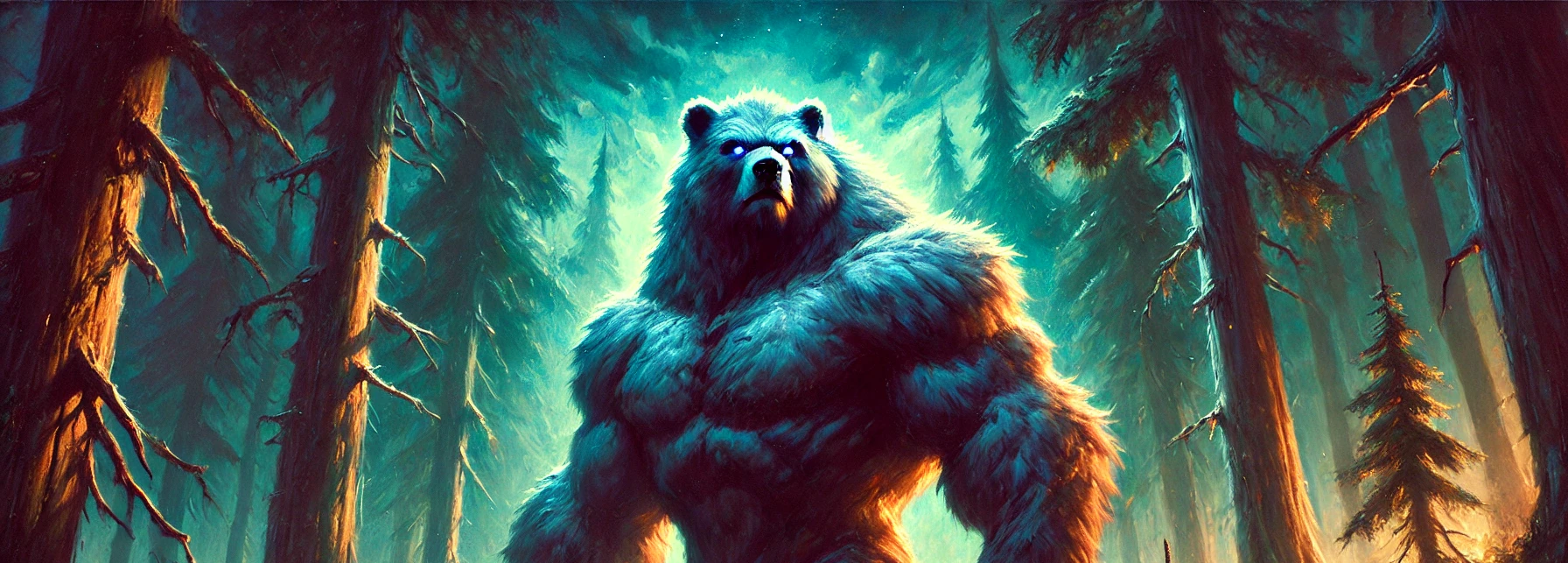Arctanthropy
Arctanthropy is the condition that grants an individual the ability to transform into a werebear, a powerful and often solitary therianthropic being. Like other types of therianthropy, it can be inherited, acquired through a bite, or transferred via a curse. However, unlike other shapeshifters, werebears have a unique connection to the wilds and the earth, often embodying the fierce protection of nature and the strength of the bear.
The transformation process in Arctanthropy is both excruciating and intense. When a human shifts into a werebear form, their body undergoes significant physical changes. The transformation involves painful bone restructuring, muscle growth, and the sprouting of thick fur. Unlike werewolves, who take on a more canine appearance, werebears take on an appearance that is a combination of both human and bear-like features. The humanoid form of the werebear is larger and more muscular than a typical human, with broad shoulders, long claws, and sharp teeth. In their bear form, the werebear takes on the appearance of a massive bear, with enhanced physical abilities such as strength, speed, and resilience.
In the initial transformations, particularly for those newly infected, the shift can be chaotic. It is not uncommon for the individual to lose control of their human mind and be overwhelmed by their bear instincts. This is a dangerous period of transition, during which the individual must learn to balance their animalistic nature with their human consciousness.
Transmission & Vectors
Like other therianthropes, Arctanthropy is typically transmitted through a near-death vector. This means that the person undergoing the transformation must be near death before the curse or gift can fully take hold. There are several methods through which an individual can become an Arctanthrope:
Genetic Inheritance: This is the most common form of Arctanthropy transmission. Werebear families, known for their deep ties to the land and ancestral customs, pass down the condition to their offspring. Typically, a werebear child will undergo their first shift in adolescence, and this shift is often something they are trained for from a young age.
Bite: A bite from an existing werebear is a potential way to acquire Arctanthropy, but it’s not as simple as a mere bite. The recipient must be on the brink of death, often from a brutal mauling or fatal injury, for the werebear transformation to take hold. The infected saliva, much like in other therianthropic transformations, carries the curse that triggers the shift. Only those who survive this near-fatal encounter can become werebears. The transformation process is incredibly painful, as bones break and reform, muscles expand, and the individual grows into their new, more powerful form.
Curse or Ritual: The least common method of contracting Arctanthropy involves a curse or ritual, typically placed on the individual by a powerful being or for a purpose. This method is typically used in cases of punishment or retribution, where the victim is unwillingly transformed into a werebear. Like the bite, the transformation can be brutal and comes with psychological turmoil, as the individual grapples with their newfound power and animalistic instincts.
Symptoms
Werebears, like all therianthropes, possess immense physical strength, speed, and agility in both their humanoid and bear forms. Their heightened senses of sight, smell, and hearing make them excellent hunters, able to track prey or threats from great distances. Their size and muscle mass provide impressive durability and resilience, allowing them to endure injury and heal more rapidly than humans. Werebears also possess an enhanced sense of healing, rapidly recovering from wounds in a way that humans cannot.
However, like all therianthropes, they have their weaknesses. Silver is known to cause damage to werebears, hindering their healing abilities and potentially leading to death if introduced into their bloodstream. Additionally, aconite (wolfsbane) can be toxic to them, interfering with their healing and causing severe physical deterioration. While their bear instincts offer them strength and resilience, they can also overwhelm them, making it difficult to maintain control during transformation or when under emotional stress.
Sequela
Like other therianthropes, Arctanthropes struggle with the internal conflict between their human intellect and bear instincts. The instincts of the bear are powerful, and many werebears struggle to control their new urges, particularly in times of stress, fear, or anger. These primal urges can lead to anger management issues, aggression, or an overpowering desire to isolate themselves from others. However, over time, mentorship from older werebears or pack leaders can help these new werebears gain control over their transformations and their instincts.
The transformation into a werebear often reinforces the werebear’s strong sense of territoriality. Many werebears become intensely protective of their land or territory, whether it’s a forest, mountain range, or river. Their sense of guardianship extends not only to their physical domain but also to those they care for, making them fiercely loyal and protective of their families and packs. This deep connection to their territory often leads them to become solitary, though some packs of werebears do exist, particularly in more remote regions.
Werebears tend to be solitary creatures, preferring to remain in small family units or alone, with little interest in forming large groups or packs like werewolves. However, some extended family groups or clans exist, and these werebears often operate together in tight-knit units for protection and mutual aid. Within these families or groups, there is often a strong hierarchy, with the most experienced or strongest werebear acting as the leader.
While werebears are typically solitary, they are fiercely protective of their territories. They will fight tooth and claw to defend their land from intruders—whether those intruders are other supernatural creatures, humans, or even other werebears. Their fierce independence and territorial nature make them both respected and feared in the wilds.
Type
Magical
Origin
Magical
Cycle
Chronic, Acquired & Congenital
Rarity
Rare
Affected Species




Comments